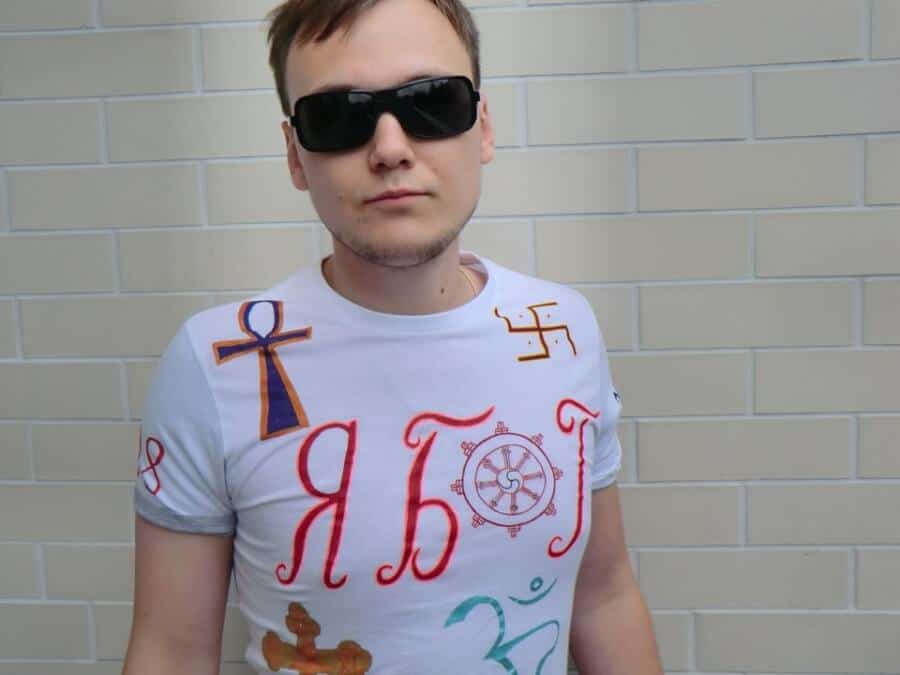What will the clothes of tomorrow look like? Interview with a young designer Denis Grivennikov.
24-year-old Denis Grivennikov is a student at a Moscow university. He would not be this issue’s star of Personalities had he not, five years ago, decided to pick up a paintbrush and paint, and depict, on one of his own white shirts, an image that had come to him once in a dream. Having started with the half-vision, half-dream only for himself, the young man just recently took his brush and bright paints to decorate the white coats of the doctors at a Moscow hospital. He now plans to do the uniforms of the tough Russian police.
Denis, first in general terms, tell us what you do?
I paint with acrylics on clothes. I paint exclusively on fabric. I choose different motifs for each painting. I try to understand the person I’m painting for, and to express their inner world. If I do one for myself then I choose the pictures as the mood takes me. I generally try to grasp at something deep. There are many pieces that take Buddhism as a theme, and other Eastern philosophies. With most of the images, I want to make people think about something spiritual. I want to promote goodness, love, fraternity, the unification of all countries and the elimination of borders and inequality.
So, your work is a philosophical message on clothing?
Yes, something like that. Some young people express their position on life via Internet blogs, social networks or on the street with a megaphone, or some are content discussing it around the kitchen table with friends. I’m trying to convey my thoughts and views through paintings on clothing.
Why did you choose this particular format?
I started to do it all in 2006. It was like a dream, or maybe not a dream, more like a daydream. I saw an image: our planet as a growing flower. There was a green stem with leaves, but where the flower should have been, there was Earth. And ever since then I see our planet as a growing organism, and it needs to be watered, protected and looked after, otherwise it might die. I’ve had this picture stuck in my head for a long time. I wanted to paint it on my wall at home but I lived in a rented apartment so I wasn’t allowed to do it. Then one day, my eyes accidentally fell on a white shirt in my wardrobe. Then I came back from a shop with an armful of fabric paint. Basically, all this ended with me buying paint and brushes and reproducing the image on the shirt. I got an important lesson out of it. I honestly never knew how to paint, but that image that was stuck in my head came out very well. It was a colourful, off-beat thing. I thought, when you’ve done it once, why not try to continue painting on wardrobe items? Now, I paint mainly for my girlfriend and friends.
Do they take part in the intricate painting process, or more often do they simply want the next big thing in fashion and request “something awesome that everyone will look at”?
It depends. But I hope that friends want to have something exclusive that will lift them beyond the ordinary consumer because I make them by hand. Whenever I paint for someone, I sit down and think so that his or her inner world is reflected. And for each person, I try to capture something of them. For example, I have a DJ friend. I painted him a heart. Around the heart were headphones with the lead plugged in to the heart. The message is this: music is inside you. But actually, I’m gradually coming out of the ‘paintings for friends’ category. I recently put my work into a social context, in the social mainstream.
Did you decorate a police officer? Their summer shirts are white.
[Laughs] Close, but no. My parents work in paediatric dentistry. I went quite recently to visit my mum at work, noticing the white coat they wear. This ignited loads of ideas for painting. Well, it’s paediatric dentistry, so I painted relevant pictures: a Cheshire cat, the rabbit from [the cartoon show] Nu pogodi!, etc. The effect has exceeded all expectations. Even my dad and brother are fans of the coats. They say that children are less scared and are smiling more. They generally respond very positively, displaying more trust in their doctors. Now the idea is to do these pieces in more serious hospitals – in the cancer ward, for example. I doubt it will happen with the police and firefighters, of course. Although maybe it could be suggested. Perhaps people in such fields could at times and to some extent supplement their intimidating work clothes.
Do you only work with pictures or does text also feature?
I do work with text. For example, I once reproduced a Maya calendar on a t-shirt. The caption on it was “2012 is coming. Open your mind”. Then someone else asked me to make him a T-shirt with the word ‘why?’ on the front in Russian and on the back in Czech. This is the universal question: why are we here? And since he was a Russian in the Czech Republic, it was done in Russian and Czech. As the guy himself explained, he wanted to draw attention to the fact that it’s not important who we are, or what nationality – we all have the same questions.
Tell me a bit about yourself. In addition to painting clothes you what else do you do?
I am finishing this year at the Russian State University for the Humanities (RGGU). Right now I’m writing my thesis. It is directly geared towards my work – its title is: “PR Techniques for the Promotion of an Exclusive Youth Clothing Fashion Brand to the European market”. Like on my site [Denis has his own page on the Internet, where anyone can view his work and make an order. Ed.], I want to present the idea that this is something higher than just the production and sale of clothing to the masses. It is for people with a non-typical, unconventional way of thinking.
So are you planning in the future to turn painting on clothes from a hobby into a profession, your own business?
For now, that’s not my aim. However, I have opened the group Vkontakte and, as I’ve already mentioned, my personal website. People have started writing to me, interested in making orders. I take any money I get from these people because it is my time and materials that go into it. But above all, I’m doing this because I really love to paint.
As an active clothes designer and future PR manager, do you think handmade products have a chance at taking a leading role? At the moment the market is flooded with mass-produced goods.
At the moment, in order to find something different, really worthwhile, you have to do a lot of digging around. But I think now is exactly the time when people are beginning to move away from the idea of being in a crowd, and are looking more inwardly. They are also approaching the idea of not following brands. Everything needs to be simpler and we need to express ourselves more. The individual portion of the public is gradually developing.
I.e. individualism in everything from toothbrushes to T-shirts is what awaits us in the future?
It’s not as dramatic as that, but in terms of clothing, furniture perhaps, home decor, cars – then yes.
And are you planning to find a place for yourself in this niche market?
If it happens, why not? But I’m more striving for people to not just to see the piece and think “oh cool, I have to order it”, but rather to look at the image and think about it. Maybe after seeing my work, people might get into religion or one of the Eastern philosophies. That’s what’s really important. That’s what would be really great and would be for me the biggest reward.
Good luck in your endeavours!
Support us!
All your donations will be used to pay the magazine’s journalists and to support the ongoing costs of maintaining the site.
Share this post
Interested in co-operating with us?
We are open to co-operation from writers and businesses alike. You can reach us on our email at cooperations@youthtimemag.com/magazine@youthtimemag.com and we will get back to you as quick as we can.










